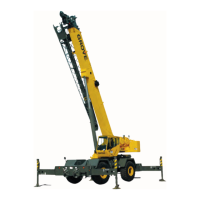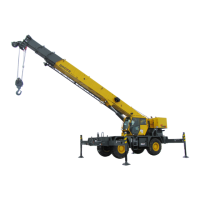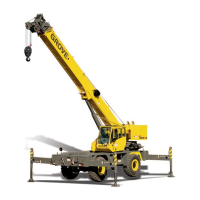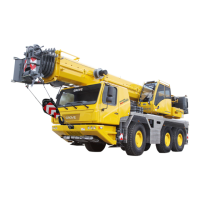Grove Published 11-10-2014, Control # 524-00 8-31
RT880E SERVICE MANUAL UNDERCARRIAGE
Outrigger Beam
Description
The outrigger beam assembly consists of an outrigger beam,
a jack cylinder, an extension cylinder, an Outrigger
Monitoring System (OMS) (Optional—Standard in North
America), and the required hoses and mounting hardware.
Theory of Operation
When the outrigger extension is activated, it extends or
retracts the outrigger beam within the outrigger box. The
outrigger beam can be extended to the mid-extend position
by allowing the lock pin to ride on the top of the beam while
it’s extending. The lock pin will automatically drop into the
hole when the beam reaches the mid-extend position.
The Outrigger Monitoring System (OMS) string
potentiometer (if equipped) is mounted inside the outrigger
box and is connected to the outrigger beam by a cable. The
string potentiometer identifies whether an extension beam is
at the fully retracted, mid-extend, or fully extended position.
The OMS communicates the position of each outrigger beam
to the Rated Capacity Limiter (RCL), aiding the operator in
accurately programming the crane’s configuration.
The jack cylinder is mounted to the end of the beam and
applies force to the outrigger beam vertically. This sequence
of events provides for lifting and stabilizing the crane for
operation.
Maintenance
Removal
1. On the jack cylinder end of the beam, remove the set
screw from the side adjustable wear pad and back off
the wear pad from the outrigger box.
2. Remove the cover from the opposite end of the outrigger
box. Remove the setscrew from the side adjustable wear
pad and back off the wear pad from the beam.
3. Remove the setscrews from the bottom adjustable wear
pads and back off the wear pads leaving approximately
0.125 in (3.2 mm) protruding
4. Extend the outrigger slightly to facilitate attaching a lift-
ing device to the outrigger beam.
5. Place blocking material under the outrigger beam.
6. Tag and disconnect the hydraulic lines at the cylinder
barrel end of the extension cylinder. Cap all lines and fit-
tings.
NOTE: Do not allow the end of the outrigger extension cyl-
inder to fall when the cylinder mounting shaft is
removed. Use blocking to limit the drop or an ade-
quate soft support to cushion any distance the rod
will drop,
7. Remove the OMS string potentiometer cable (if
equipped) from the attaching point on the outrigger
beam.
NOTE: Avoid free-release of cable to prevent damage to
OMS string potentiometer caused by over-range of
cable.
8. Remove the cotter pin and clevis pin securing the cylin-
der barrel end of the extension cylinder to the outrigger
housing. Carefully extend the outrigger beam until the
extension cylinder is free of the housing and carefully lay
the end of the cylinder on the bottom of the outrigger
beam or leave on blocking.
NOTE: Do not allow the end of the outrigger extension cyl-
inder to fall when the cylinder mounting shaft is
removed. Use blocking to limit the drop to prevent
damage to the OMS string potentiometer (if
equipped).
OMS string potentiometer may be easily removed
to avoid damage during extension cylinder pin
removal. Refer to Outrigger Monitoring System
(Optional—Standard in North America), page 8-36.
NOTE: Lifting belts or straps should be used for lifting pur-
poses so as to avoid nicking or scratching the bot-
tom edges of the outrigger beam (Figure 8-31).
9. After attaching a suitable lifting device of straps or belts
instead of chains to prevent nicking the bottom edges of
the outrigger beam, pull the outrigger beam out of the
outrigger box, re-adjusting the lifting attachment to pre-
vent the extension cylinder from sliding out of the outrig-
ger beam when the beam clears the outrigger box.
NOTE: The outrigger beam assembly weighs approxi-
mately 1474 lb (669 kg).
10. Position the outrigger beam on the blocking material.
Inspection
Inspect the outrigger beams for bends, evidence of cracks,
or other damage. Check the outrigger beam internally for
hydraulic fluid, which may indicate a leaking cylinder, loose
connection, or damaged hydraulic line.
WARNING
Be sure any blocking material used is capable of
supporting the weight of the outrigger beam. Do not allow
it to tilt or slide.
WARNING
Be sure any blocking material used is capable of
supporting the weight of the outrigger beam. Do not allow
it to tilt or slide.
